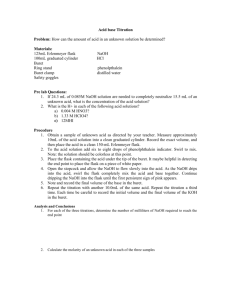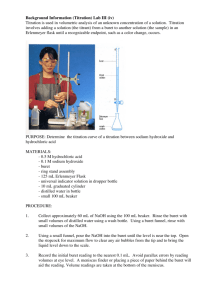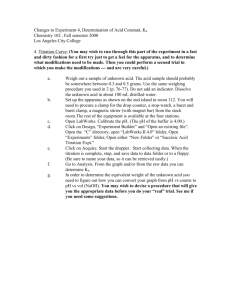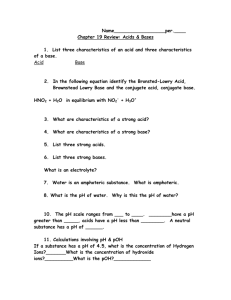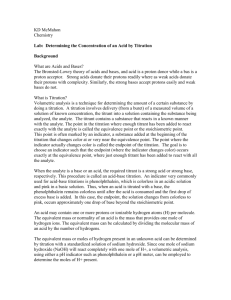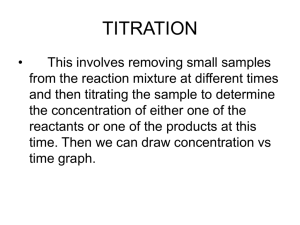SCH3U 8.5 Acid-Base Reactions : Titrations
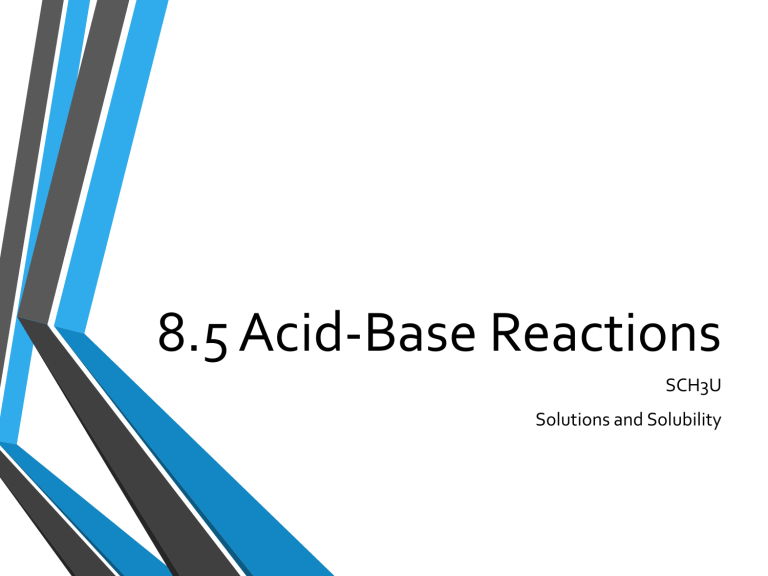
8.5 Acid-Base Reactions
SCH3U
Solutions and Solubility
Reactions Involving Acids
•
Acids take part in several characteristic reactions:
1.
Active metals react with acids in a single displacement reaction
• active metal + acid hydrogen + ionic compound
•
Mg
(s)
+ 2HCl
(aq)
H
2(g)
+ MgCl
2(aq)
Reactions Involving Acids
2.
All acids react with carbonates in a double displacement reaction
• carbonate + acid carbon dioxide + water + ionic compound
•
Na
2
CO
3(s)
+ 2HNO
3(aq)
CO
2(g)
+ H
2
O
(l)
+ 2NaNO
3(aq)
Reactions Involving Acids
3.
Acids undergo precipitation reactions with some ionic compounds
• ionic compound + acid precipitate + acid
•
Pb(NO
3
)
2(aq)
+ 2HI
(aq)
PbI
2(s)
+ 2HNO
3(aq)
Reactions Involving Acids
4.
Acids react with bases in another double displacement reaction often called a
neutralization reaction
• base + acid ionic compound + water
•
NaOH
(aq)
+ HCl
(aq)
NaCl
(aq)
+ H
2
O
(l)
8.5 Acid-Base Titration
SCH3U
Solutions and Solubility
Acid-Base Titration
•
Titration
• a laboratory procedure involving the carefully measured and controlled adding of a solution from a buret into a measured volume of a sample solution
• it is used to determine the concentration of substances in solution
•
Titrant
• the solution in the buret during a titration (standard solution with KNOWN concentration)
Titration Apparatus
Titration of an Acid with a Base
•
In the buret standard solution of base
(KNOWN concentration)
•
In the flask precise volume of acid
(UNKNOWN concentration)
•
In the flask indicator to detect the end point
Titration of a Base with an Acid
•
In the buret standard solution of acid
(KNOWN concentration)
•
In the flask precise volume of base
(UNKNOWN concentration)
•
In the flask indicator to detect the end point
The Endpoint
•
Endpoint
•
the point in a titration at which the indicator changes colour
•
this is at, or close to, the point at which the titrant and sample in the flask have completely reacted
PHTH titration
The Endpoint
Steps of a Titration
1.
Place standard solution in buret
2.
Place a precise volume of a solution of unknown concentration in a flask
3.
Add an indicator to the flask
4.
Record the volume in the buret as your initial reading
5.
Open the stopcock of the buret and allow the standard solution to enter the flask, while swirling the flask
6.
Slow down the flow of standard solution being added to ensure you don’t surpass the endpoint by too much
7.
Once the end point is reached, record the final volume in the buret
8.
Subtract the initial volume from the final volume in the buret to obtain the total volume of standard solution used to neutralize the unknown solution.
A Titration Sample Problem
•
25.0 mL of an acid rain sample containing sulfurous acid was analyzed in a laboratory using a titration with a standard solution of sodium hydroxide (0.105 mol/L). Use the evidence given in the following table to determine the concentration of the sulfurous acid.
HOMEWORK
•
Read Section 8.5 (pg. 393 – 397)
•
Answer “Practice” #6 – 11 on pg. 399 – 400


